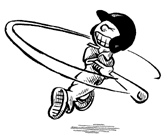
|
Physics and Acoustics of Baseball & Softball Bats
Daniel A. Russell, Ph.D. Graduate Program in Acoustics The Pennsylvania State University The contents of this page are ©2003-2011 Daniel A. Russell | 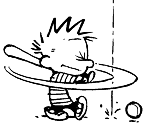
|

|
Physics and Acoustics of Baseball & Softball Bats
Daniel A. Russell, Ph.D. Graduate Program in Acoustics The Pennsylvania State University The contents of this page are ©2003-2011 Daniel A. Russell | 
|
|
Disclaimer: This article is an attempt to bring the problem of illegal bat modification to the attention of the general public by openly exposing the various techniques of illegally improving bat performance that are currently popular in men's slow-pitch softball and are beginning to make alarming headway into organized youth baseball (especially travel leagues) and fast-pitch women's softball. This article describes some of the more popular techniques currently being used by players, especially in slow-pitch softball. It may be that some readers will use the contents of this article to attempt to modify their own bats, (or their kids' bats), and they will do so at their own risk and peril. I will not be held responsible if any reader is caught and sued for altering a bat using the popular techniques described in this article. My greater hope is that the general public - parents and players who may not have been aware of this growing problem - will become aware of the extent to which illegal bat modifications can actually increase the performance of a metal or composite bat, and being aware, can start speaking out against the practice of illegally modifying softball and baseball bats. |
Many players attempt to artificially improve the performance of their bats by altering them in such a way that they will hit balls faster, but without the alteration being visible. Popular bat alterations include painting, end-loading, and shaving the barrel. Other players, who are aware that the performance of composite bats tends to improve with use, attempt to shorten the time for a bat to reach its maximum performance by employing an accelerated break-in (ABI) techniques to improve the performance of their bats. There is some disagreement about whether or not ABI techniques actually fall under the category of "bat doctoring" - so I will address ABI techniques in a separate article.
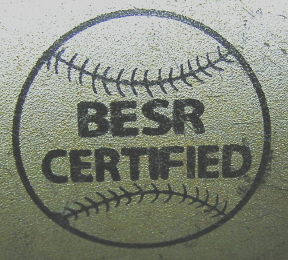
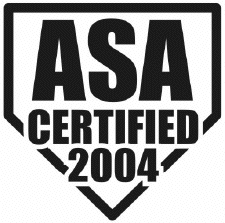 Many bat designs have been patented by manufacturers. Modifying the design of the bat, while passing if off as an original, is a violation of the manufacturer's patent and copyright. Furthermore, all bats approved for play in the ASA, USSSA, NSF, ISF, NCAA, Little League, or any other governing body bear a certification mark which means that a particular bat model has tested in a rigorous laboratory experiment in which its performance has been measured and found to fall below some set standard. These certification marks are federally registered trademarks, and altering a bat so that it exceeds the certified level of performance is considered a federal crime. Several manufacturers and governing bodies have been successfully filing and winning lawsuits against bat doctors for violation of trademark and patent rights. The ASA has recently been awarded two $100,000 judgements in lawsuits filed against individuals who illegally altered bats bearing certification stamps, and several other lawsuits are pending.
Many bat designs have been patented by manufacturers. Modifying the design of the bat, while passing if off as an original, is a violation of the manufacturer's patent and copyright. Furthermore, all bats approved for play in the ASA, USSSA, NSF, ISF, NCAA, Little League, or any other governing body bear a certification mark which means that a particular bat model has tested in a rigorous laboratory experiment in which its performance has been measured and found to fall below some set standard. These certification marks are federally registered trademarks, and altering a bat so that it exceeds the certified level of performance is considered a federal crime. Several manufacturers and governing bodies have been successfully filing and winning lawsuits against bat doctors for violation of trademark and patent rights. The ASA has recently been awarded two $100,000 judgements in lawsuits filed against individuals who illegally altered bats bearing certification stamps, and several other lawsuits are pending.
The problem of players using altered bats is most rampant in adult men's slow-pitch softball.[1] However, comments on several discussion boards indicate that the trend of shaving composite bats has begun to makes its way into organized youth baseball and also girls' fast-pitch softball. The seriousness of this problem in men's slow-pitch softball has attracted the attention of governing bodies and associations, to the extent that both the USSSA and ASA have begun imposing severe penalties for players caught using altered bats. The USSSA checks bats at national tournament and has implemented fierce penalties for players caught using altered bats. If a bat is suspected of having been altered, the player must turn it over to the USSSA for testing. If the bat is found to have been altered, the player is automatically banned from USSSA play for two years. If the player refuses to submit his bat for testing, he is automatically banned for one year. During the 2004 national USSSA tournament, 500 bats were tested using a portable barrel compression device. 70 bats failed the test, and 25 of those bats were found to have been altered (the other 45 were cracked or otherwise damaged and were destroyed).
Besides these legal issues, there are also serious safety concerns. This is especially true for kids playing youth baseball, but is just as serious a concern for adults playing in recreational league. A player who uses an altered bat that can hit balls at 104-mph or faster is putting pitchers and fielders at potentially serious risk, especially if those fielders are expecting balls to be hit at 98-mph or lower.
| One method of "doctoring" a bat doesn't really involve changing structural properties of the bat, only its visual appearance. An extremely high performance bat - most often a model that has been banned - is disguised to look like a bat model which is legal. The pictures at right were posted by a "bat doctor" who was offering his services on eBay in the Spring of 2004. The eBay posting included a photo of the guy's equipment in his garage. The guy started with an extremely high performance Miken Ultra, sandblasted the original paint finish off, repainted the bat black and polished it, and then fixed the fake decals to disguise the bat as a legal Viper 14 (you can even see the fake ASA 2000 certification stamp on the barrel on the left side of the photo). |
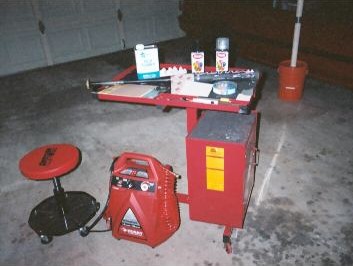 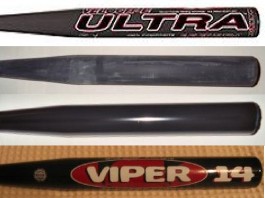
|
|
Some of the jobs are pretty good - that is, if you don't know what you are looking for. As is the case with any forgery, if you know the original well enough, you can spot the fake. But some bat doctors are good enough that a disguised illegal bat would be pretty hard to spot if you weren't looking really closely - or if you didn't have the real thing to compare with. The photo at near right[2] shows an extremely high performance Miken Ultra 2 disguised to look like a Miken Freak 98 (which passes the ASA 2004 98-mph performance standard), along with an actual Miken Freak 98. The differences in the graphics are noticeable, but the differences probably wouldn't attract the attention unless someone was comparing the two bats side by side.
For disguising illegal titanium slow-pitch softball bats, a popular target choice for a while seemed to be the Cryogenic Equalizer 2. The photos at far right show three disguised titanium bats which were all offered for auction on eBay in May 2004: (from top to bottom) a Worth Ti Titanium, Easton Typhoon Titanium, and Louisville Slugger TPS Titanium, all painted to look like a Cryogenics Equalizer 2, complete with fake ASA 2000 certification stamp. If you look closely you can see the differences in the end caps between the three bats. |
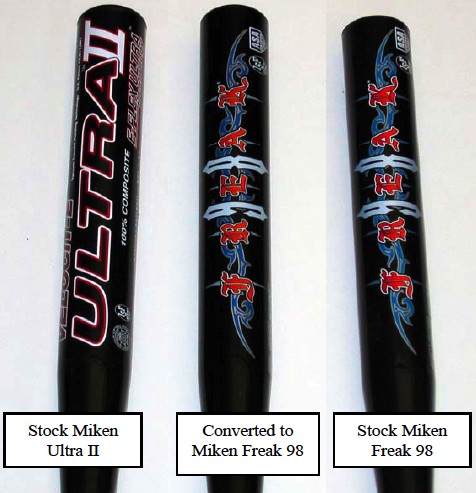
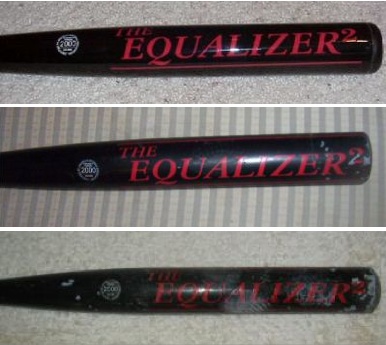
|
| Whether the disguised bat is an extremely high performance composite or titanium bat, the fact is that a player who uses such a bat is using a bat which exceeds the performance limits set by the governing association and is lying about it by disguising the bat as a legal model. Attempting to pass off a bat as having a maximum batted-ball speed of 98-mph (which is what the ASA certification stamp means) when it really produces batted-ball speeds of 104-mph or higher, is not only an obvious violation of the rules of the sport, but can also be extremely dangerous to a pitcher or infielder who is not prepared to field a ball traveling 6-10 mph faster than they expect. | |
|
There have been a number of studies showing that (assuming a player can maintain the same bat-swing speed) using a bat with a larger moment-of-inertia (MOI) will enable the player to hit balls faster and farther.[3-8] So it is not surprising to find that another popularly used technique is to alter the weight distribution - either by adding weight to the barrel end or by moving weight from the knob to the barrel without altering the total weight - so that the balance point moves further out from the handle and the moment-of-inertia increases. According to some Senior Softball discussion groups, one of the more popular high performance bats (Miken Ultra 2) is often end-loaded by simply removing the iron rod in the handle.
The bar chart at right[2] shows the batted-ball speeds measured for four bats (single-wall aluminum, wood, multi-wall composite, and multi-wall aluminum) before and after the moment-of-inertia had been increased by 20%. The increase in moment-of-inertia was obtained by adding weight to the barrel end of the bats in a fashion similar to that used by some of the more popular bat doctors. In all four cases, the increase in moment-of-inertia resulted in an increase in batted-ball speed, usually by about 3 mph. |
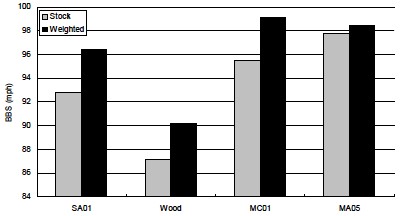
|
|
One of the most effective means of illegally altering a bat's performance is to reduce the thickness of the barrel walls. The thinner the walls, the more elastic the barrel, and the greater the trampoline effect - resulting in faster hit ball speed. Of course thinning the walls too much creates a durability problem since thinner walls are more likely to crack or dent. A shaved bat is more likely to break or crack than an unmodified bat, or even a naturally broken-in bat.
Shaving the inner surface of a bat barrel is relatively simple as long as you have access to a good lathe. It is done by removing the end cap (without scratching the outside of the barrel end), using a lathe to shave material from the inside of the barrel, and then replacing the end cap. The photograph at right shows a lathe used by a bat doctor ready to shave the inside of a composite bat. Many composite bats are multi-wall bats, meaning that the bat barrel is comprised of two or three layers of composite materials. Shaving the inner layer greatly weakens it to the point that it may break and fall apart, causing the bat to sound like one of those rain sticks. While the performance of such a bat may go way up for a while, the durability is greatly compromised. But, it cannot be disputed that shaving a bat to make the barrel wall thinner does indeed improve performance. The two graphs below were provide to me by a manufacturer and show the measured batted-ball speeds for an aluminum bat (left graph) and composite bat (right graph) for which the walls were successively shaved. Removing 0.01" of material in the aluminum bat increases the batted-ball speed by 4-mph. If the original bat had the ASA certification stamp (indicating batted-ball speed below 98-mph), the modified bat now well exceeds the ASA performance limit and is now illegal. The change in the composite bat is even more dramatic. Starting with a production model bat and shaving off 4 plies on the inner diameter increases the batted-ball speed by 6.5-mph. This bat, which originally came in just under the 98-mph limit now drastically exceeds the limit, with a measured batted-ball speed of 104-mph. |
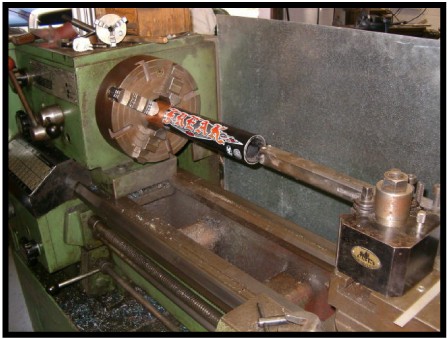
|
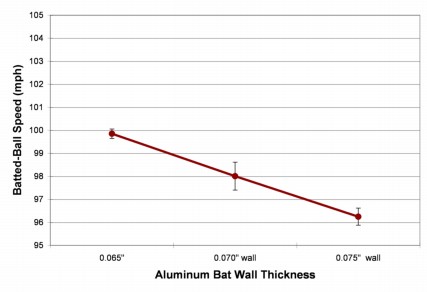 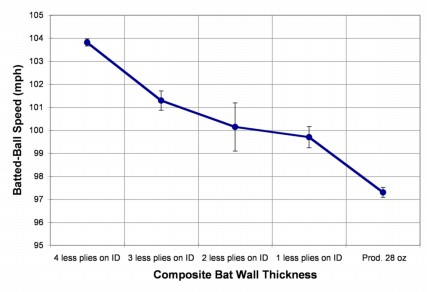 | |
| The bar chart at right shows the measured change in performance for several aluminum and composite slow-pitch softball bats both before and after sending them to a bat doctor for shaving.[9,10] The bats labeled "MAxx" are multi-walled aluminum bats and those labeled "MCxx" are multi-walled composite bats. The batted-ball speed for very single bat improved by at least 2-mph, with some bats improving by almost 8-mph. The ASA performance limit is 98 mph, and every single one of these doctored bats exceeds this upper limit after being shaved. In other words, every one of these altered bats is now illegal.
Just to put an 8-mph increase in performance in performance in perspective, the difference between a softball leaving a bat at 98-mph and a softball leaving a bat at 106-mph is about 62 feet in additional distance travelled. |
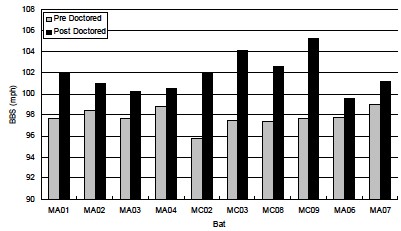 |
The elastic properties of the bat barrel, that give rise to the "trampoline effect", are relatively easy to measure. I am aware of at least two prototype portable devices currently under development that may see use in the field in the near future. Both of these prototypes measure the elastic trampoline effect of the barrel and can identify bats which exceed set performance standards. The trampoline effect of the barrel is directly related to the stiffness of the barrel. That stiffness may be measured directly using a compression device, or indirectly by measuring the hoop frequency of the bat vibration. Any alteration of the structural properties of the barrel becomes evident when one looks at the vibration or acoustic signature of the bat.
Painting or camouflaging a bat is a purely visual alteration, and many bat doctors have become very good at hiding the results of their techniques so that an umpire visually inspecting a bat will often not be able to tell that the bat has been altered - or camouflaged. However, camouflaging the bat with paint is not able to hide the elastic properties of the barrel. It is relatively easy to detect that a painted bat has an elastic property that would cause it to exceed the performance standards.
So, if you are considering altering a bat to enhance its performance, be aware that such alterations are relatively easy to detect, and associations are cracking down pretty heavily on those to attempt to cheat by illegally altering their bats. Personally I don't think it is worth riskng a $100,000 lawsuit in order to get a few extra home runs. If you are a player, or parent of a player, and you hear others talking about altering bats or playing with altered bats, then you should raise your voice against this practice.
Back to Physics and Acoustics of Baseball & Softball Bats